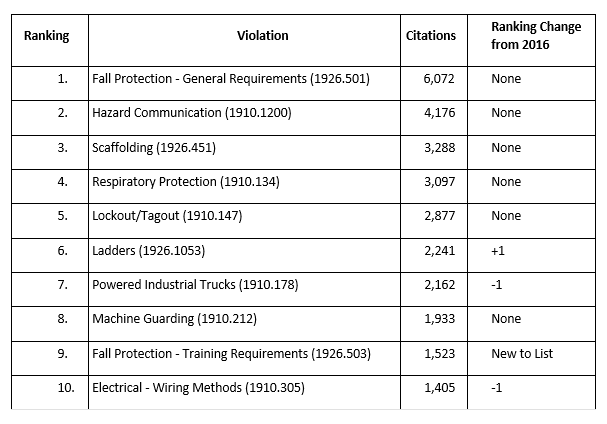OSHA’s 2017 Most Frequently Cited Violations

Patrick Kapust, deputy director of OSHA’s Directorate of Enforcement Programs, revealed the list of Top 10 OSHA violations for 2017 (preliminary) at the National Safety Congress and Expo in Indiana on Sept. 26 in Indianapolis.
The Top Citations of 2017:

“One thing I’ve said before in the past on this is, this list doesn’t change too much from year to year. These things are readily fixable,” Kapust said during the presentation. “I encourage folks to use this list and look at your own workplace.”
Key Notes to Consider
The top five citations are the same as they were in 2016. Although Fall protection remains the top cited violation, this year’s number is down 857, or 12.4 percent, after rising by 208 from 2015 to 2016. Ladders moved up one spot from last year’s list, and switched places with Powered Industrial Trucks.
Fall Protection – Training Requirements is new to the list this year. Common violations for 1926.503 include failure to train workers in identifying fall hazards and proper use of fall protection equipment. While 1926.501 frequently violated requirements include unprotected edges and open sides in residential construction and failure to provide fall protection on low-slope roofs.
Note that that OSHA’s top ten cited standards account for dozens of industries and as an employer, you need to seek out the top citations in your specific industry as it may vary. Use this page here, to list the most frequently cited Federal or State OSHA standards for a specified 6-digit North American Industry Classification System (NAICS) code.
“When we all work together to address hazards, we can do the best job possible to ensure employees go home safely each day.” – Deborah A.P. Hersman, National Safety Council President and CEO.
OSHA publishes this list to alert employers about these commonly cited standards so they can take steps to find, fix, and recognize hazards addressed in these and other standards before OSHA shows up. Far too many preventable injuries and illnesses occur in the workplace and it’s important to keep your workers protected.
